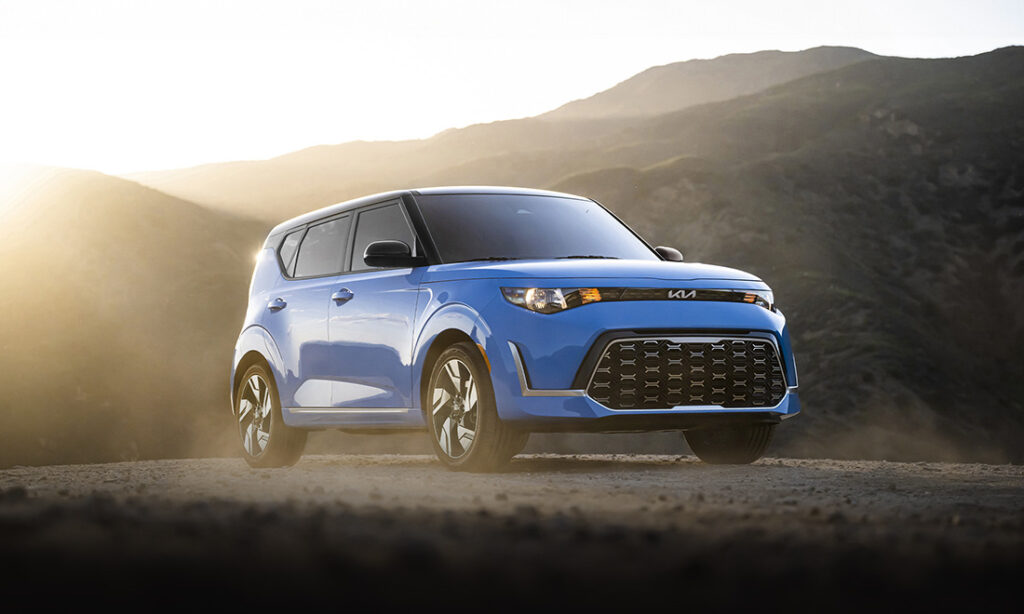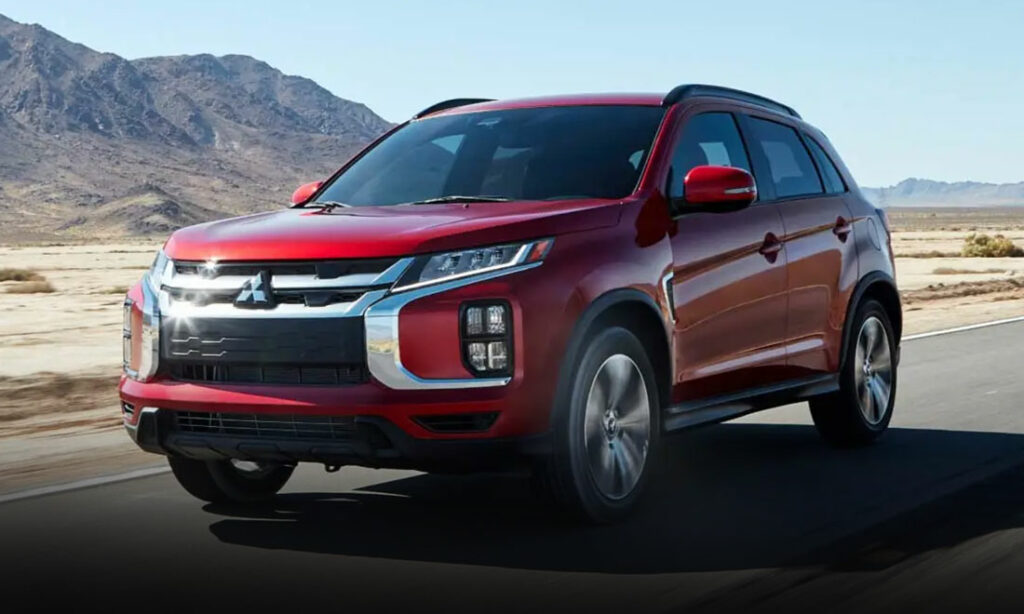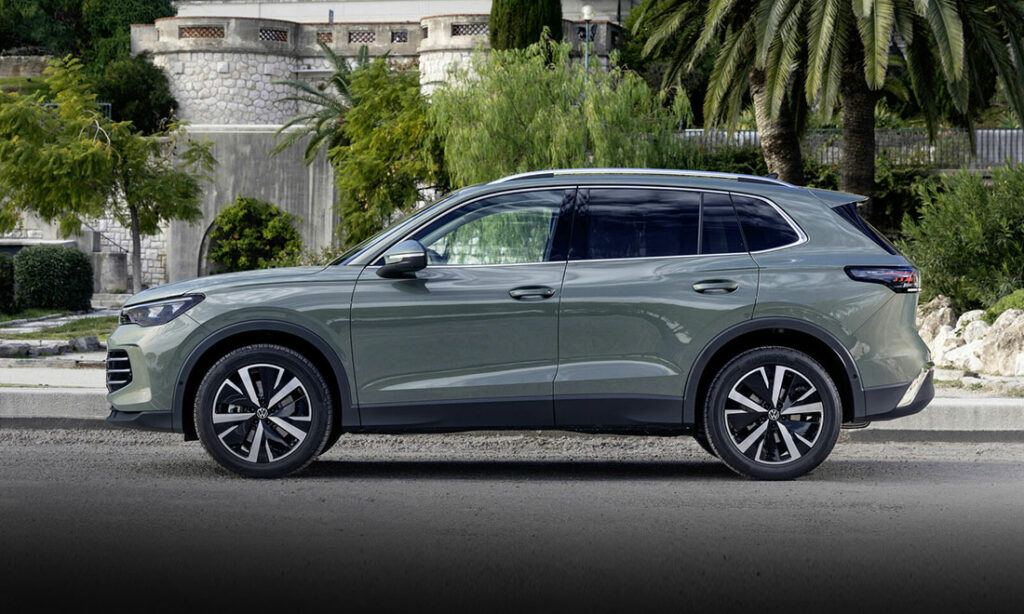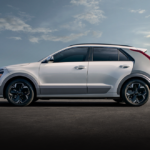Ford Thunderbird Through the Years
The Ford Thunderbird is an icon that birthed the personal luxury car category. Read about the birth and growth to old age of the mighty Ford Thunderbird.
Remembering the Ford Thunderbird
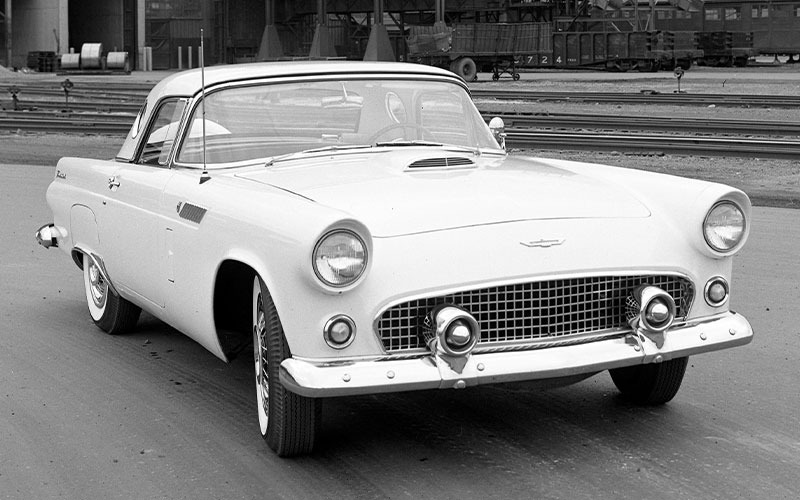
1956 Ford Thunderbird – media.ford.com | Shop Ford Thunderbird on Carsforsale.com
George Walker and Louis D. Crusoe were the guys behind one of Ford’s most iconic cars. While Ford was known for its sedans, the company felt it needed a sportier vehicle in their model line-up, mainly to compete against Chevrolet’s Corvette. Enter, the Ford Thunderbird.
The “Thunderbird” name came from a Ford designer referencing a Native American legend of supernatural bird that represented power, speed, and strength. The more boring creation of the name involved the Thunderbird Country Club in Rancho Mirage, California. It’s said that Ernest Breech, a Thunderbird Country Club member who was then chairman of Ford Motor Company, asked his Club’s permission to use the name. Both may be true, but either way we can be grateful that Ford passed on some of the earlier 5,000 name recommendations, including Beaver, Apache, and Tropicale.
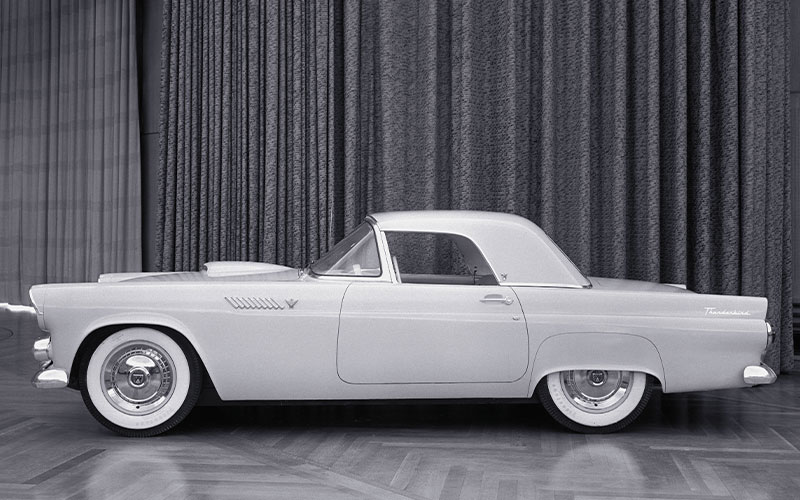
Once Ford decided to move forward on the Ford Thunderbird, it was on the showroom in less than two years. Even now, that’s considered a remarkable turn-around. This “true Ford sports car” was introduced to the market in 1955. While the Thunderbird’s size may have changed, it stayed true to its concept as a personal luxury car for 50 years.
First Generation (1955–1957)
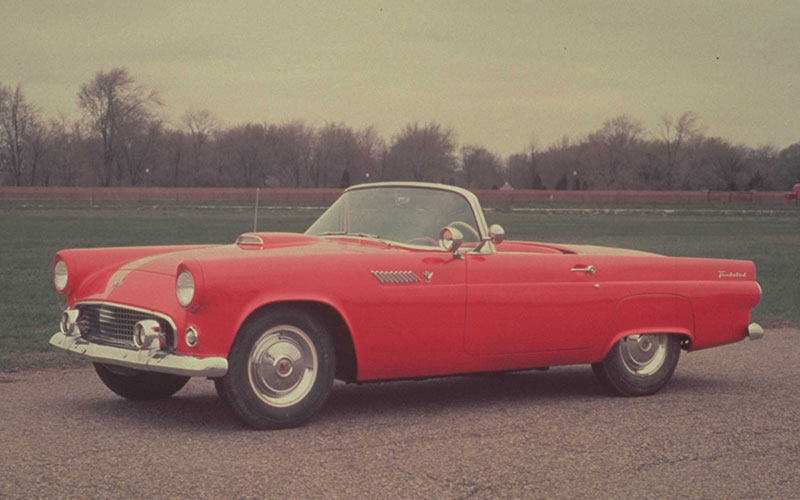
The Ford Thunderbird was designed to be a sporty two-seat convertible. However, Ford knew they couldn’t fully compete with Chevrolet‘s new Corvette and saw the opportunity to position the Thunderbird as an upscale model. Ford didn’t know it at the time but soon discovered that it made an entirely new segment later known as the personal luxury car.
- Known as the “Baby Birds”, the 1955 Thunderbird launched with prices that ranged from $2,695 and $4,000.
- Production of the Ford Thunderbird began on September 9, 1952, and sales for the 1955 Thunderbird started on October 22, 1954.
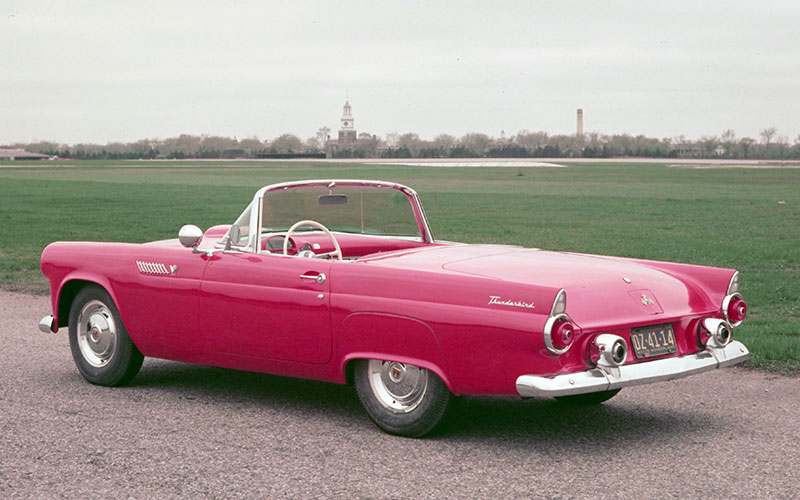
- The Thunderbird, while inspired by and competing directly against the Corvette, wasn’t a true sports car. Ford called the Thunderbird a personal car. The Ford team focused its design, content, and marketing more on luxury and comfort.
- Some of Ford’s luxury and convenience options included their Dial-O-Matic power seats, electrically operated windows, and a radio that automatically adjusted the volume in proportion to the engine‘s speed.
- While picking up styling clues from other Ford models, the Thunderbird was made sleeker. It featured a hood scoop and an exclusive 150 mph speedometer, but its top speed was 100 mph.
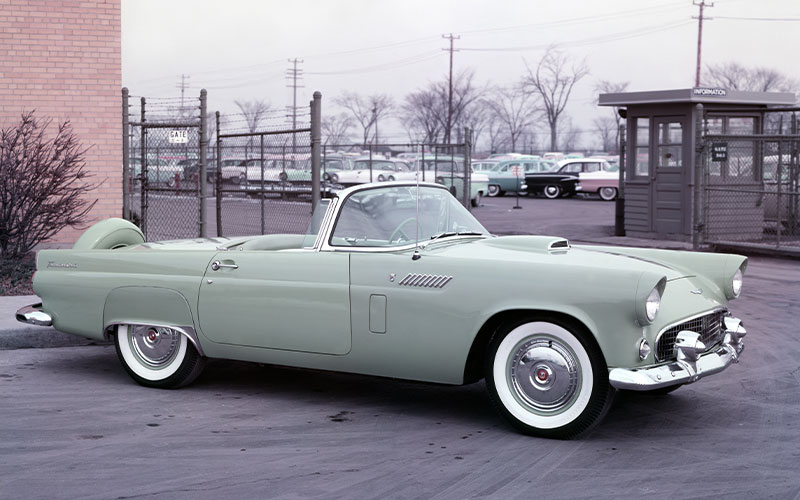
- The frame of the Ford Thunderbird provided a wheelbase of 102 inches, but was just a shortened version of the same frame used in other Fords at the time.
- The only engine choice in 1955 was a 292 CID V8 that was produced by Mercury.
- For 1956, Ford updated the Thunderbird by moving the spare tire to a continental-style rear bumper that expanded trunk storage, but it affected its handling. Ford also added porthole windows in the c-pillar to aid visibility.
- A new 215 horsepower 312 CID V8 engine was introduced in 1956. Ford hooked it up to a 3-speed “Ford-O-Matic” automatic transmission.
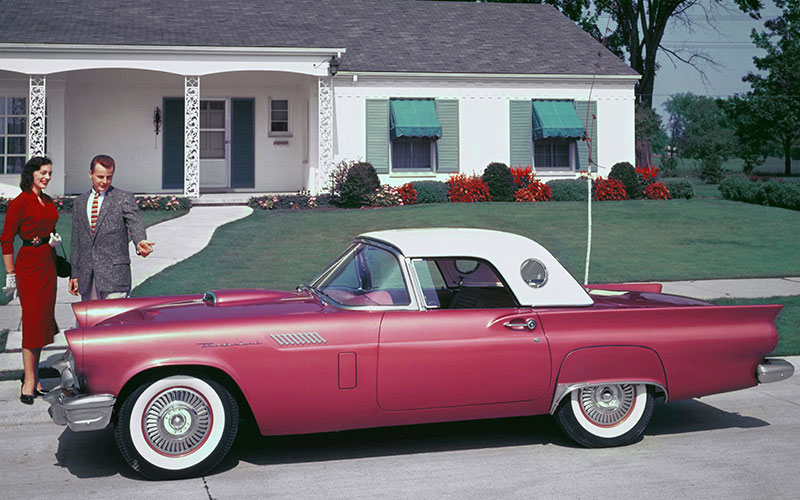
- In 1957, discovering the error of the spare tire move, Ford lengthened the rear of the Thunderbird and relocated the tire to the trunk.
- Ford also redesigned the Thunderbird to have a more prominent grille, larger tailfins, and had re-styled the dashboard for 1957.
- The 1957 Ford Thunderbird added round gauges inside of a single instrument cluster, replacing the original horizontal layout.
- The 1957 Ford Thunderbird’s standard V8 was updated to put out 245 horsepower.
- Ford also offered an optional 312 CID V8 with two four-barrel carburetors and fitted a supercharger that helped the Thunderbird get 300 horsepower.
Second Generation (1958–1960)
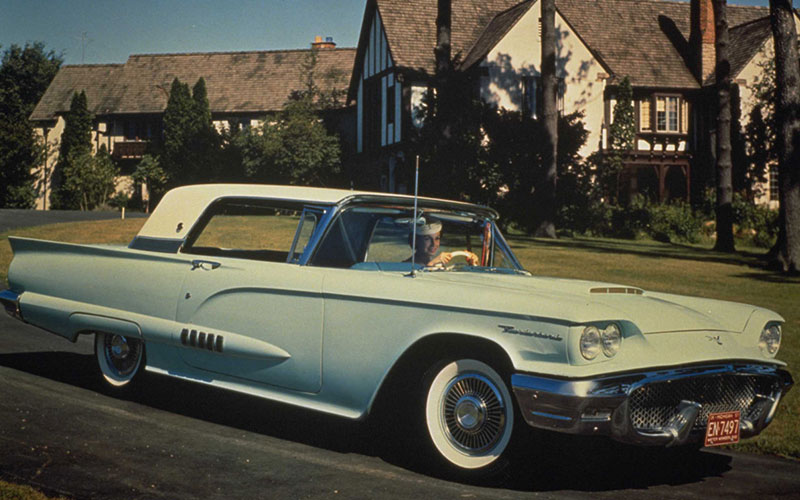
Even with the success and upward sales of previous Thunderbirds, Ford didn’t rest on their laurels. To expand their market, Ford set out to redesign the Thunderbird’s next generation. The two-door 1958 Ford Thunderbird could now carry four people. This was the right marketing choice since Ford proceeded to sell more cars than the previous model.
- Second generation Thunderbirds were known as “Square Birds”.
- The new Ford Thunderbird design rocketed sales towards to a number of 200,000 vehicles over three years.
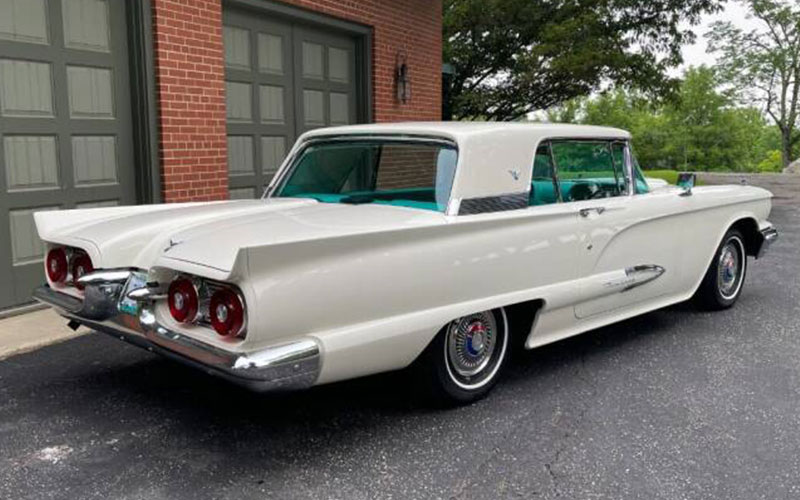
- The 1958 Ford Thunderbird was sold in a hardtop and convertible. The convertible wasn’t available until five months after the hardtop had launched.
- Ford add a new rear seat, extending both the passenger size and the Thunderbird’s wheelbase.
- The Thunderbird’s more rigid construction and extra length added 800 extra pounds to the vehicle.
- Ford also updated the styling of the Thunderbird with quad headlights, larger tailfins, chrome grille, and a larger hood scoop (albeit non-functional).
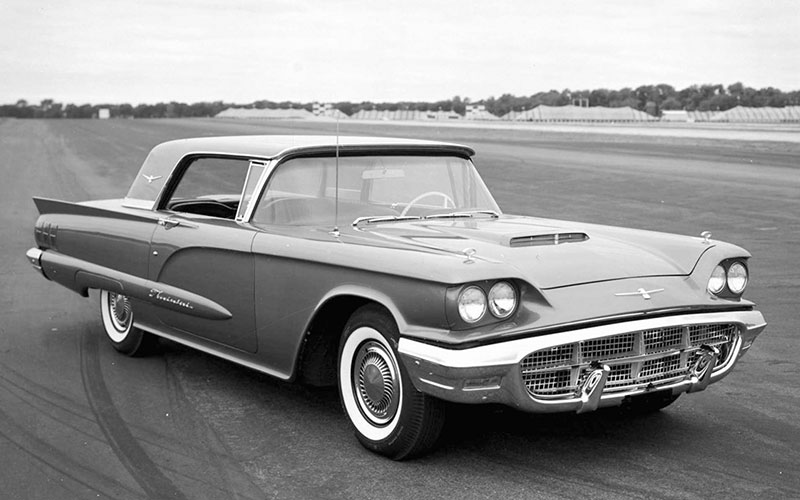
- The Thunderbird received a new 352 CID V8 in 1958 that made 300 horsepower and was paired to an updated 3-speed manual or automatic transmission.
- Horsepower sells, and in 1959, Ford introduced its 430 CID V8 engine that made 350 horsepower to the Thunderbird lineup.
- The Ford Thunderbird also appeared on the NASCAR track in 1959 and won six races in the top division.
- In 1960, Ford redesigned the rear lights and tailfins before ending the second generation.
Third Generation (1961–1963)
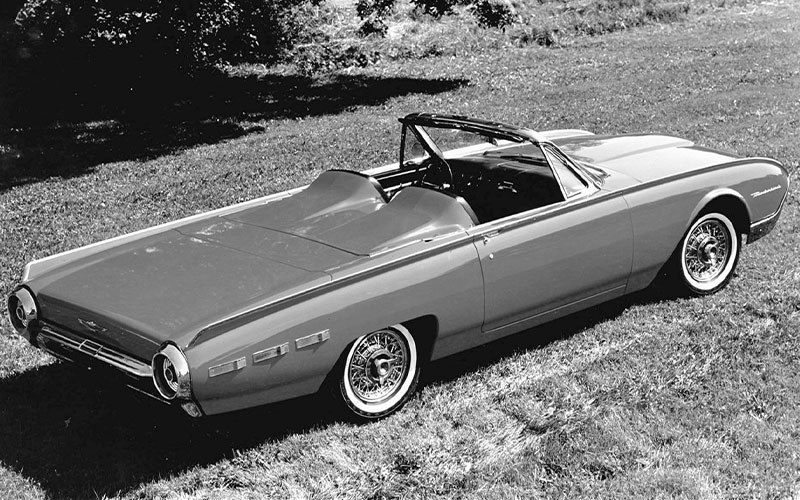
Ford once again redesigned the Thunderbird and gave the 1961 model the sleek shape. The new Ford Thunderbird appeared as the pace car for the 1961 Indianapolis 500, and it also appeared as a regular in the hit TV series 77 Sunset Strip.
- This Ford Thunderbird was named the “Bullet-Bird”.
- Ford introduced a new 390 CID V8 engine with 300 horsepower.
- In 1962, Ford introduced a Sports Roadster package for the convertible models that made it look like a two-seat roadster by adding a cover for the rear seats and 48-spoke wire wheels.
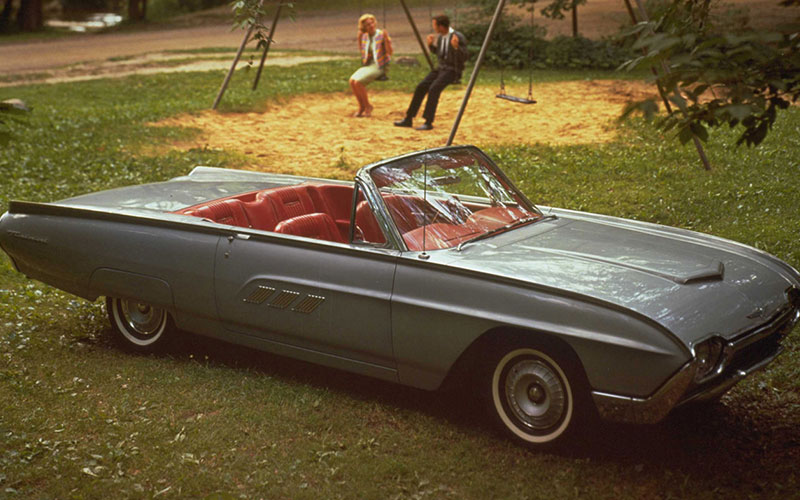
- The majority of third-generation Ford Thunderbirds were ordered with rear-fender shields.
- 1962 also saw an available upgraded version of the 390 CID V8 with three Holley two-barrel carburetors known as the M-Code. This update increased the official horsepower to 340. Only 200 of these M-Code engine Ford Thunderbirds were sold.
- In 1963, Ford began putting alternators into their cars instead of the typical generator.
Fourth Generation (1964–1966)
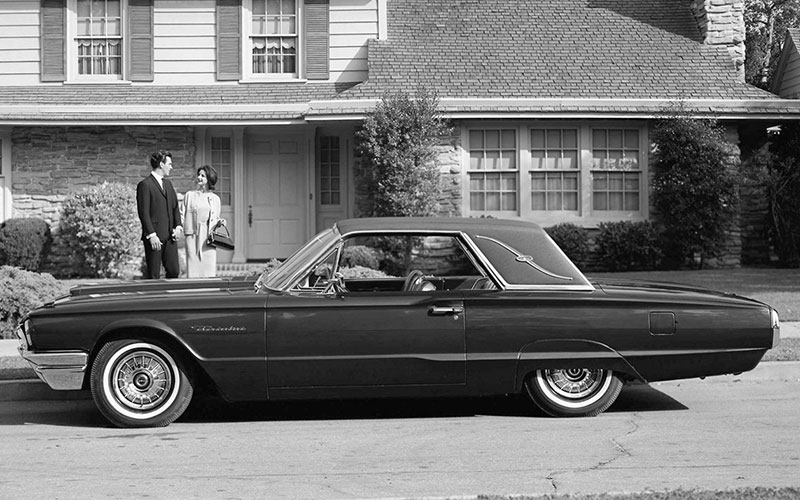
A new generation arrived, and so did a unique style. The 1964 Thunderbird moved from its sleek styling to a blunter appearance. The square look and more formal edges replaced the aero look of the front and rear.
- Fourth-generation Ford Thunderbirds were named “Jet-Birds”.
- Ford had redesigned the Thunderbird, but kept the same grille and quad headlight design.
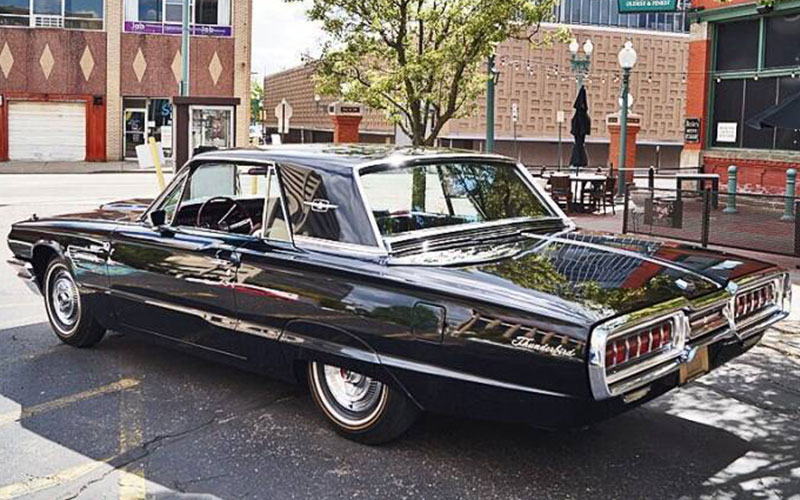
- In 1965, Ford added an optional high-performance 428 CID V8 that developed an official 345 horsepower. With this engine, the Ford Thunderbird could hit 0-60 mph in 9 seconds and gave it a top speed of over 120 mph.
- Ford added front disc brakes and a doubled-sided key to the fourth-generation Ford Thunderbird.
- 1965 was also the year that the Thunderbird gained its iconic sequential rear turn signals.
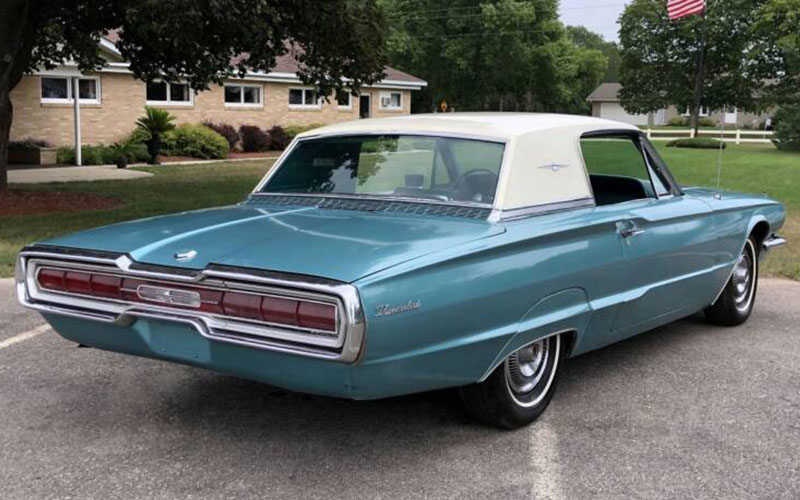
- In 1966, the Thunderbird was given a full-width taillight design.
- A rare 427 CID V8 engine was available for special order. Ford made 120 of these high-performance Thunderbirds.
- A Ford Thunderbird with the 427 could run from 0-60 mph in 6 seconds flat and reach a top speed of 135 mph.
- Ford ended the Thunderbird convertible trim in 1966.
Fifth Generation (1967–1971)
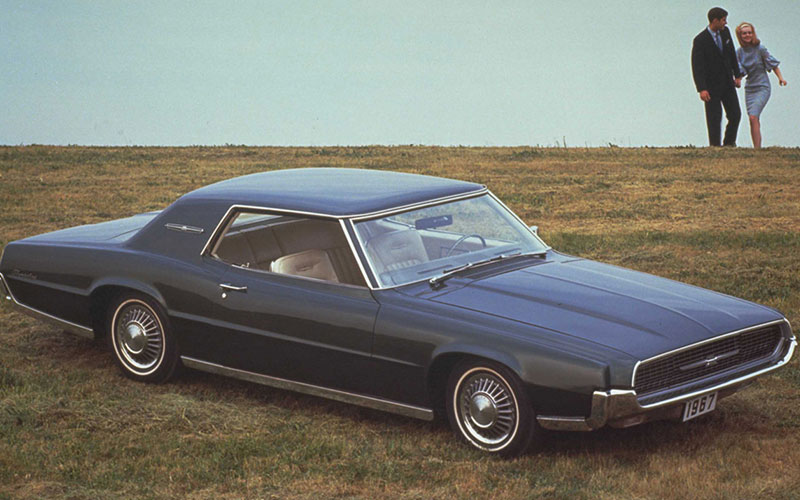
Ford’s own Mustang, introduced in 1964, created the biggest competition for the Thunderbird. The Mustang’s low price, two doors, and two rows of seats in a hardtop or convertible form forced a change to the Thunderbird. As a result, the Thunderbird took on a completely new look and moved to a luxury tourer segment. Unfortunately, this change and the engine restrictions brought a significant hit to the Ford Thunderbird legacy as a sports-oriented personal luxury car. As a result, the fifth generation is the least appreciated generation.
- The fifth-generation Ford Thunderbird was sarcastically called the “Glamour Bird.”
- Initially, Ford sold more 1967 Thunderbirds than the previous year. However, sales dropped each year after that.
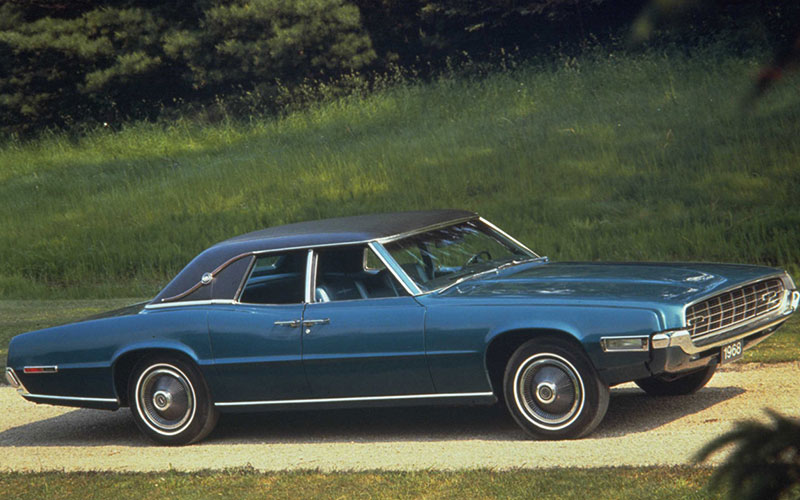
- The Thunderbird’s new and horizontally gaping mouth with hidden headlights did little to help sales.
- Ford changed the Thunderbirds construction from a unibody to a body-on-frame structure. This construction provided better isolation of road vibration, harshness, and noise with Ford’s new and sophisticated bushings.
- For the first time, Ford introduced a four-door version of the Ford Thunderbird.
- The four-door Thunderbird used rear “suicide doors” with hinges at the rear of the door instead of the front. This design continued through 1969.
- Ford’s 360 horsepower big block 429 CID V8 engine arrived in 1968 to help move the two-ton Thunderbird along the road a little more quickly with an 8.1 second 0-60 mph time.
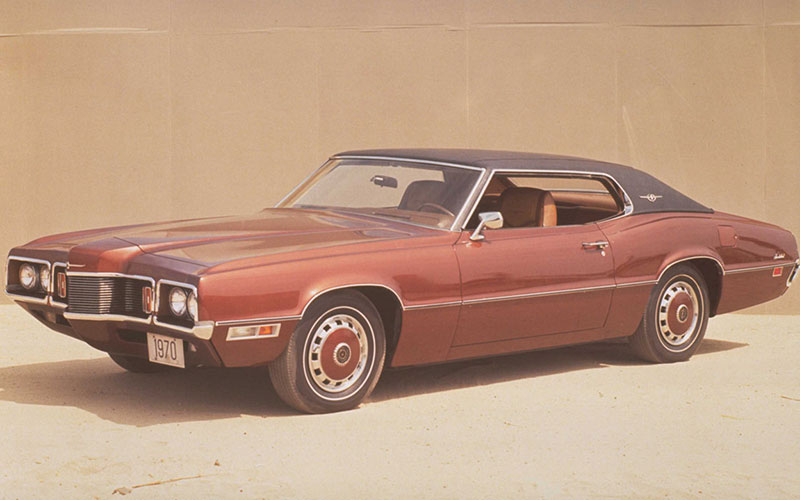
- In 1970, Ford updated the “fish-mouth” of the Thunderbird by narrowing it and adding what Ford called a proud bird beak. Pushed onto the design team by Ford president Bunkie Knudsen, it was labeled the “Bunkie Bird”.
- In 1971, Neiman-Marcus offered his and hers Ford Thunderbird models in their Christmas Catalog. This $25,000 pair included onboard telephones and tape recorders.
- After hearing consumer’s complaints about the styling and the never-loved four-door addition, Ford re-configured a new design for the next-gen and the deletion of the extra doors.
Sixth Generation (1972–1976)
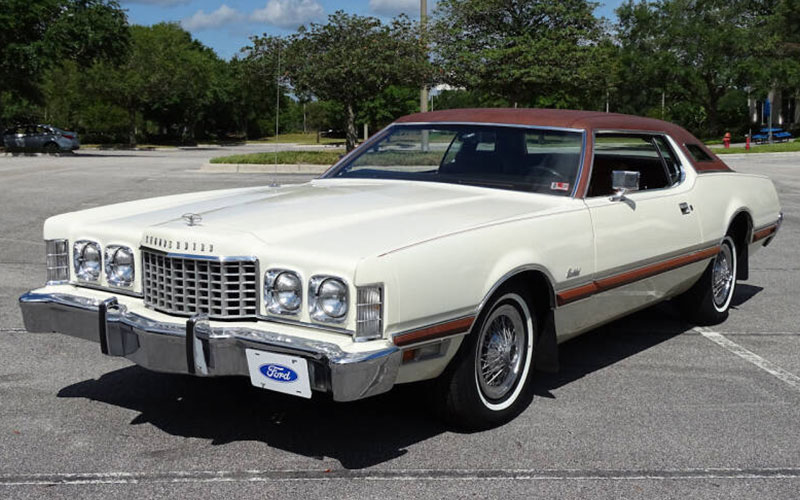
The long-hooded Ford Thunderbirds of the sixth-generation redesign were the largest Thunderbirds ever built. It wasn’t just the body that was huge, however. The engines were also the largest cubic inch engines ever installed in the Thunderbird. Even though emission controls sapped horsepower from once-powerful engines, buyers still bought them up. As a result, the Ford Thunderbird’s sales increased.
- The sixth-generation Ford Thunderbird grew to 225 inches long, rode on a 120.4-inch wheelbase, and shared its assembly line with the Lincoln Continental MK IV.
- The Thunderbird was powered by either a standard 429 CID V8 engine or a massive 460 CID V8 engine.
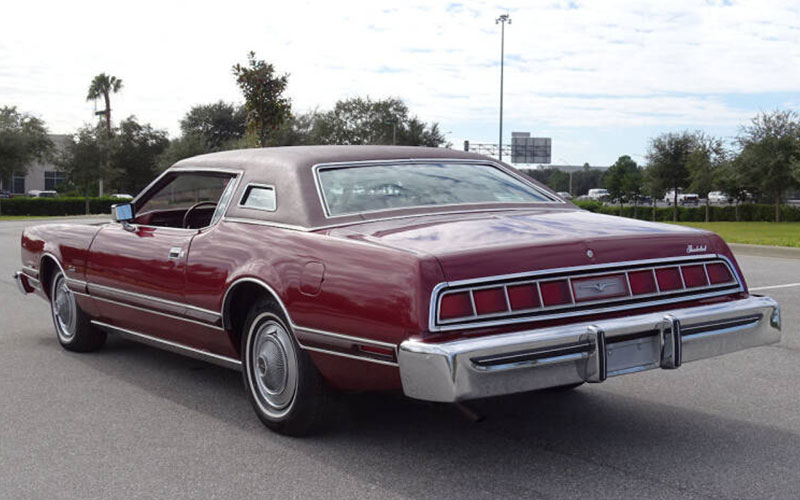
- The 460 CID engine only produced 212 horsepower, and the smaller 429 CID dribbled out a mere 160 horsepower. Because of emissions controls, the 70s was the wrong decade for horsepower.
- Fuel mileage for the Ford Thunderbird was just 8 mpg in the city and 12 mpg on the highway.
- The interior had leather seats, automatic climate control, and 6-way power seats.
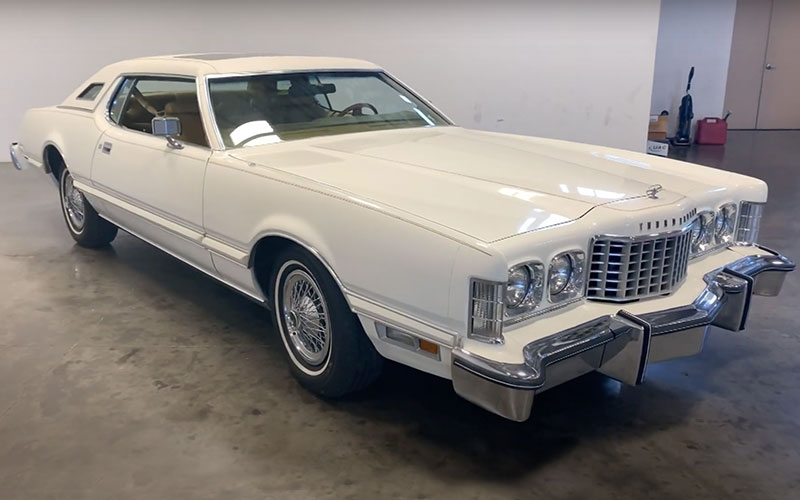
- Even though the Thunderbird was huge, the instrument panel was minuscule. The fuel gauge was centered in a prominent view of the driver to remind you that you get only 8 mpg around town.
- The giant Ford Thunderbird weighed over 4,800 pounds when fitted with the larger V8. It was still highly popular, and by 1973, Ford peaked in sales of 87,000 models.
- In 1973, the Oil Crisis caused the low mpg Ford Thunderbird sales to plummet. Ford was forced to redesign and offer a new smaller and more efficient Thunderbird.
Seventh Generation (1977–1979)
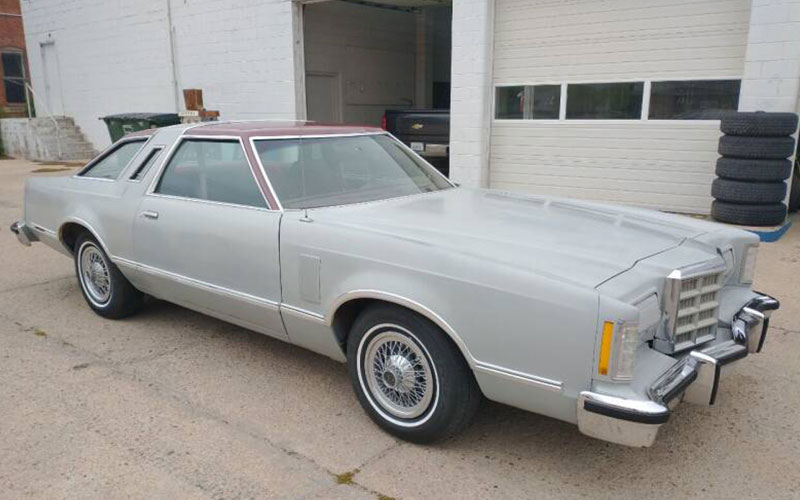
The seventh generation of Ford’s Thunderbird saw a chassis move to the one that served as a foundation for the 1972-76 Ford Torino. Although the new Thunderbird’s wheelbase shrank, it was still a visually large vehicle. The 1977 Thunderbird was a radical change from earlier T-Birds with its angular styling cues.
- The seventh-generation Thunderbird came in three trim versions: Thunderbird, Town Landau, and Heritage Edition.
- Ford made the Thunderbird a solid “near-luxury car” with its wrap-over roof and opera windows.
- The seventh-generation T-Bird was powered with a standard 130 horsepower 5.0-liter V8 and a massive 6.6-liter V8 with only 173 horsepower. Both were paired to a 4-speed automatic transmission.
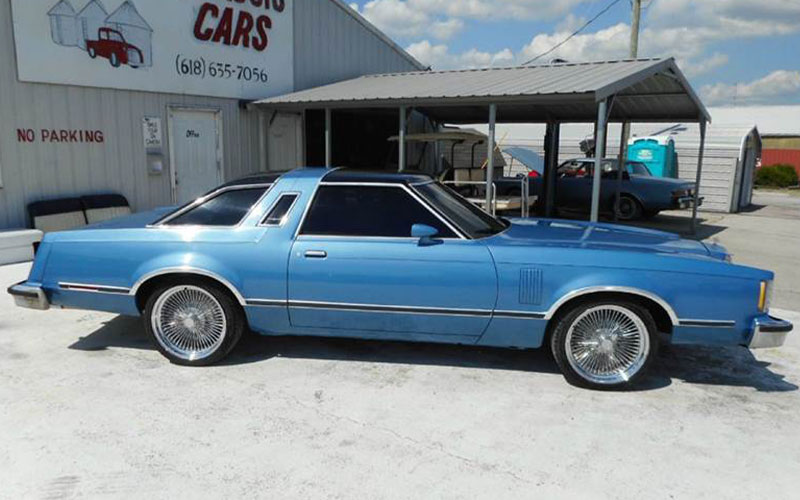
- Despite the lack of horsepower and torque for such a large car, the Ford Thunderbird could reach 60 mph in less than 10 seconds.
- The Thunderbird’s long hood and the short rear deck were something that the buyers wanted. Sales of this generation increased dramatically even though competing with the Chevrolet Monte Carlo and Pontiac Grand Am.
- The 1977-79 Ford Thunderbird sold just under 1 million units in three years, making it the most successful Thunderbird generation in sales volume per year.
- Beginning in 1977, Ford Thunderbirds replaced the Torino as Ford’s NASCAR racecar.
Eighth Generation (1980–1982)
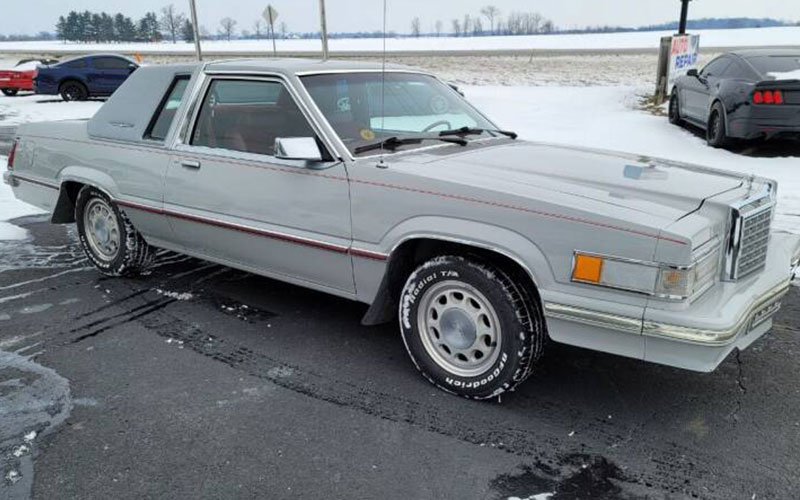
In 1980, Ford’s new Fox platform became the foundation for an eighth-generation Ford Thunderbird. The compact platform, which was the basis of the Ford Fairmont, shrunk 5.6 inches in wheelbase and over 17 inches in total length. Ford built the eighth-generation Thunderbird off the angular styling clues from the previous models. It was reminiscent of the previous Thunderbird, but in a shrunken form. Regardless of the Thunderbird’s exterior look, it was packed with the latest electronics and luxury. Unfortunately, the public’s reception of this Ford Thunderbird was less than enthusiastic.
- Ford’s eighth-generation Thunderbird retired the body on frame construction and went back to a unibody. This change cut over 800 pounds of weight compared to the previous generation.
- The smaller Thunderbird also had better steering and handling than any previous Thunderbird.
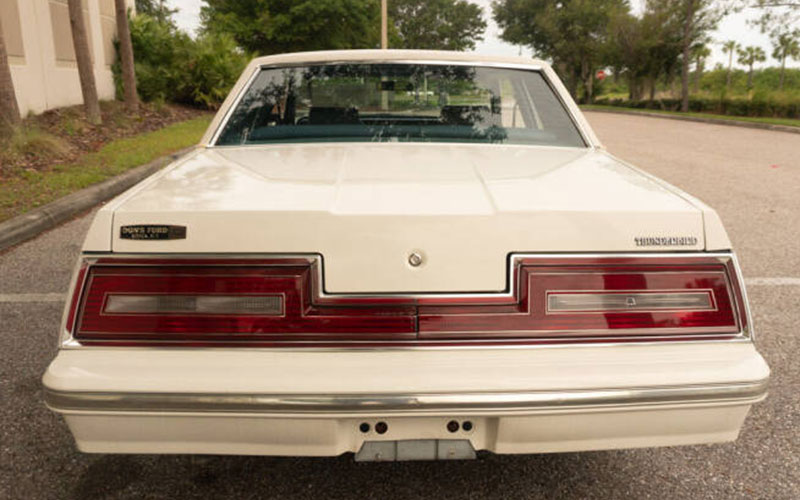
- Retractable headlights reappeared on the 1980 Thunderbird and continued to utilized the padded roof and opera windows.
- Ford included a ground-breaking keyless entry system that continues in today’s Lincoln Navigator.
- The Ford Thunderbird also had electronic readouts for the speedometer, fuel display, and other systems, hinting at what we would be experiencing decades later.
- Ford packed the eighth-gen Thunderbird with the latest available luxury and convenience items, including a high-end cassette stereo with a digital tuner that was ahead of its time.
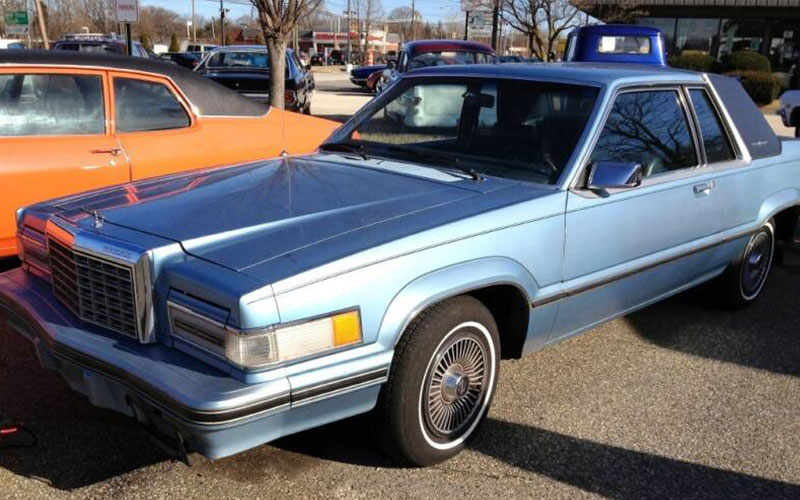
- Sales for this generation of Thunderbird were down compared to the previous model. People were beginning to move toward imports and four door models.
- In 1981, Ford dropped the 5.0-liter engine for an anemic 88 horsepower 3.3-liter straight-6 engine. This engine was replaced the following year by a 3.8-liter V6.
- With the current Thunderbird losing sales and nearing the end of its life, Ford realized that it needed something different. The new 1983 Thunderbird had an entirely new look.
Ninth Generation (1983–1988)
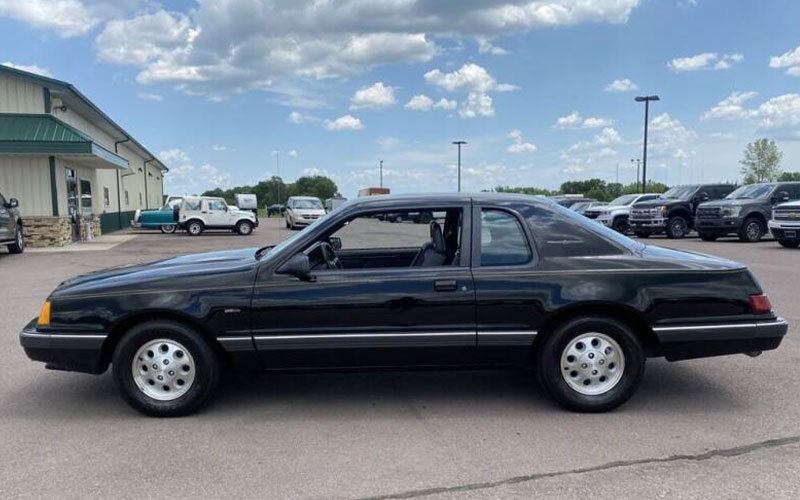
Ford knew they had to do something drastic. So, the ninth-generation Ford Thunderbird took on a more aerodynamic body in response to the growth of imported automobiles sales. Ford’s newest Thunderbird was still built on the Fox-body, but had a slightly shorter wheelbase at 104.2 inches.
- Ford changed the exterior of the Thunderbird to reflect consumer’s desires for slick aerodynamics and fuel efficiency.
- The ninth-generation Ford Thunderbird continued with the 3.8-liter V6 and 4.9-liter V8 for engine options.
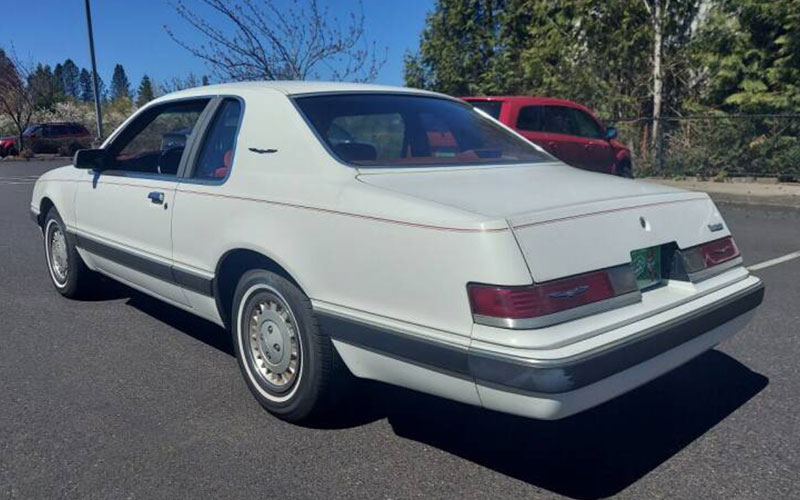
- The 1983 Thunderbird Turbo Coupe received a new 142 horsepower 2.3-liter turbo 4-cylinder. Its 0-60 time was 8.8 seconds and had a top speed of 125 mph.
- To change the Thunderbird’s public perception, Ford showed off the turbo version of the car at Laguna Seca. The turbocharged Ford Thunderbird lapped Laguna Seca Raceway two seconds faster than a BMW 633csi.
- The Turbo Coupe had “articulated” front sport seats with thigh extensions and inflatable lumbar support.
- In 1984, Ford Ford produced a Fila-branded Ford Thunderbird as a cross-promotion with the Italian fashion company. This was the first and last special edition.
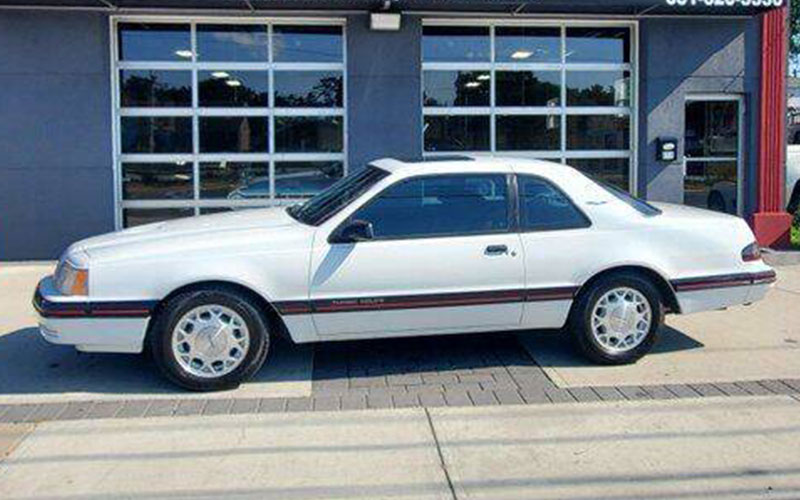
- In 1985, the turbo 4-cylinder engine’s horsepower grew to 155 and it was available with a 5-speed transmission.
- By 1987, the Ford Thunderbird needed a significant exterior update to match other Ford models. The front grill and headlights were redesigned to look more aerodynamic and align better with the rest of Ford’s lineup.
- In 1987, the 2.3-liter turbo received an intercooler and increased to 190 horsepower.
- Bill Elliot won the 1988 NASCAR racing championship in the ninth-generation Ford Thunderbird.
Tenth Generation (1989–1997)
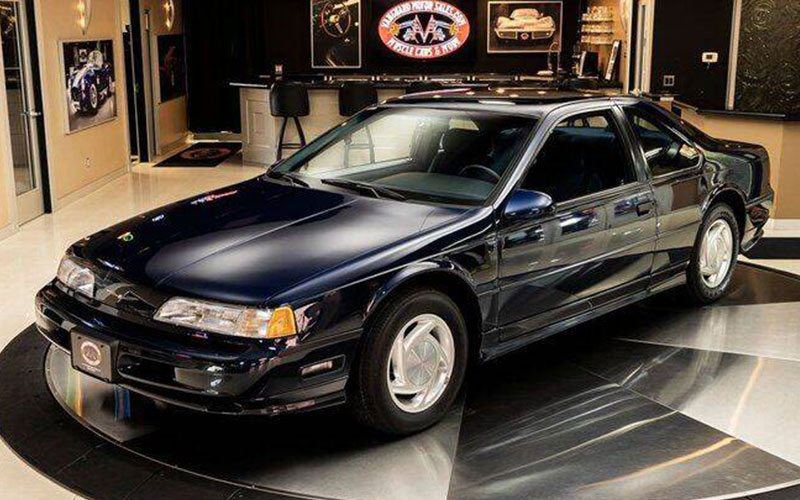
The tenth-generation Ford Thunderbird moved a little closer to the first-generation’s original concept. The 1989 Thunderbird replaced the mediocre Fox chassis that had held it back during the ’80s and moved to a better and more sophisticated platform. Ford also gave the Thunderbird a new supercharged V6 with the promise of better performance.
- The 1989 Ford Thunderbird had a similar side profile and layout as the BMW 6-series of the same time.
- This was the first Thunderbird in history not to have an available V8 engine.
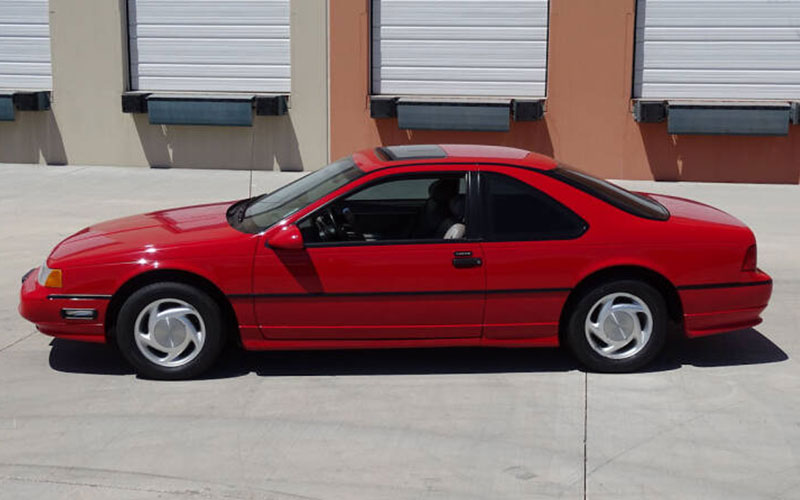
- Ford offered a “Super Coupe” edition with a supercharged and intercooled 3.8-liter V6 putting out 210 horsepower and 315 lb-ft of torque.
- The supercharged V6 accelerated from 0-60 mph in 7.5 seconds.
- The Ford Thunderbird’s standard engine was the non-supercharged V6 version with 140 horsepower.
- In 1991, the Ford Thunderbird once again received a V8. The 5.0-liter V8 put out 200 horsepower, just 10 short of the supercharged V6 available.
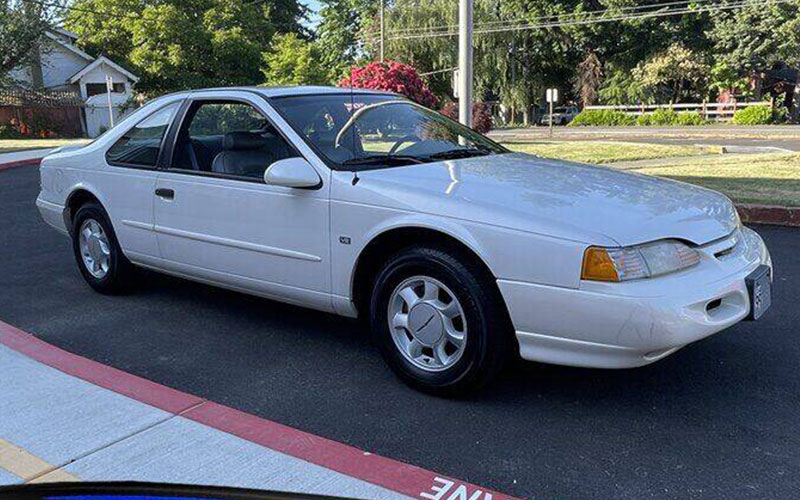
- In 1992, Ford offered a Thunderbird Sport with the V8, exterior stripes, and fog lamps.
- A new 4.6-liter V8 replaced the 5.0-liter version. The Thunderbird Super Couped received an updated and more powerful supercharged V6 instead of the V8.
- Ford’s new modular 4.6-liter had 200 horsepower and, by 1994, increased its power to 230 horses and 330 lb-ft of torque. This V8 became the tenth-generation Ford Thunderbird’s most popular engine.
- The Thunderbird had available shock absorbers that could adjust to road conditions.
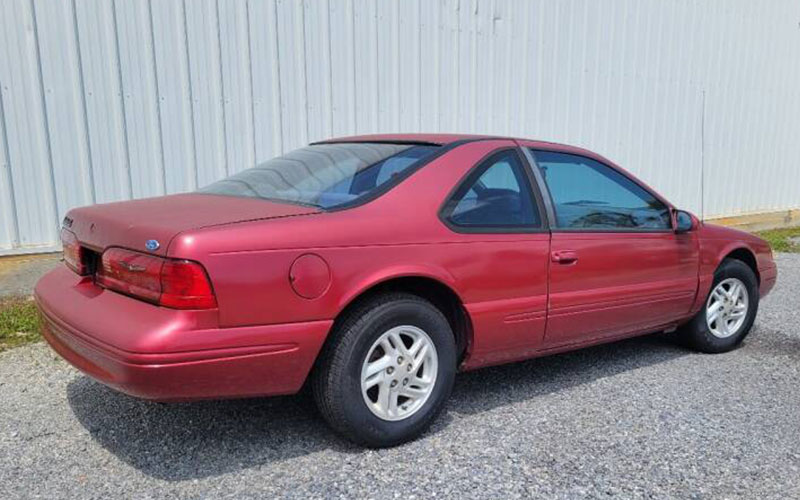
- In 1995, the Ford Thunderbird Super Coupe was discontinued, but its suspension upgrades became a sport option.
- Even though the Thunderbird had its 40th Anniversary during this generation, Ford did little to commemorate it.
- Ford’s Special Vehicle Engineering Division proposed a high-performance Ford Thunderbird based on the new modular 4.6-liter V8, but Ford declined.
- SUVs started to make coupes less popular, so Ford shut down the Thunderbird’s production line after the 1997 model year.
Eleventh Generation (2002–2005)
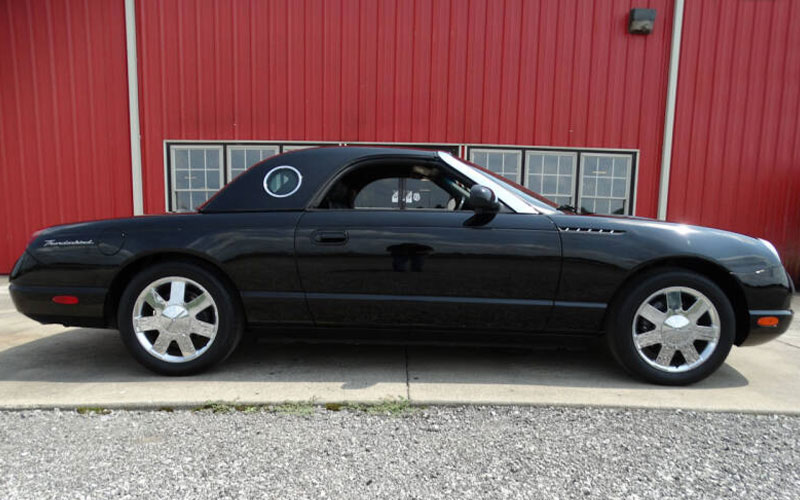
2002 Ford Thunderbird – carsforsale.com | Shop Ford Thunderbird on Carsforsale.com
At the 1999 Detroit Auto Show, amidst a retro revival from other models like the 240z, the public saw the return of a Ford Thunderbird concept that harkened back to the two-seat convertible of 1955. However, when the Thunderbird was eventually produced and sold in 2002, the new Thunderbird lost some of its momentum. After the 2002 launch, it sold 31,368 vehicles, but in 2003, the sales dropped to 14,678. Nevertheless, the new retro look Ford Thunderbird stayed in production until it finally disappeared in 2005.
- In 2002, Ford began selling the new Ford Thunderbird in hopes of rebooting the franchise.
- The eleventh-generation Thunderbird was similar to the 1955 T-Bird with a two-passenger cockpit with a convertible or removable hardtop roof.
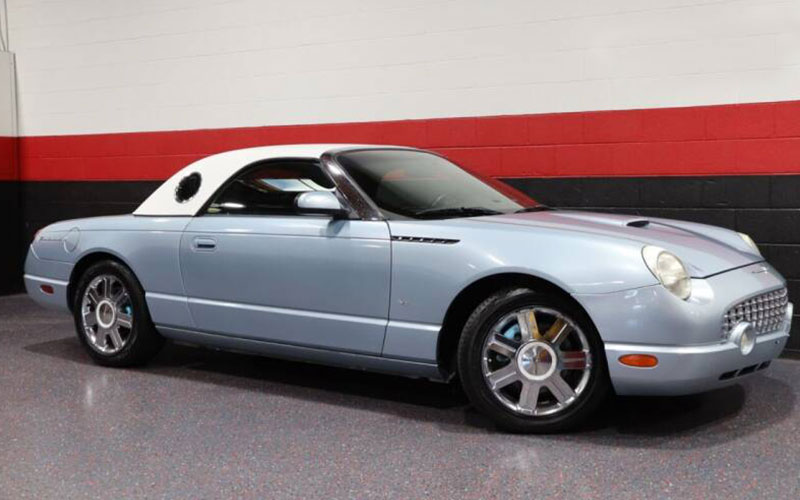
- Ford built the new Thunderbird on the Jaguar S Type/XF and Lincoln LS chassis. Although Ford gave it an original exterior and convertible structure, the interior materials and styling were from a Lincoln LS.
- Ford gave the new Thunderbird a Jaguar-designed 3.9-liter V8 with 252 horsepower and 267 lb-ft of torque.
- Variable timing and electronic throttle control were added in 2003 and upped the power to 280 horsepower and 286 lb-ft of torque.
- In 2003, a 5-speed automatic with manual-shift mode was an available option.
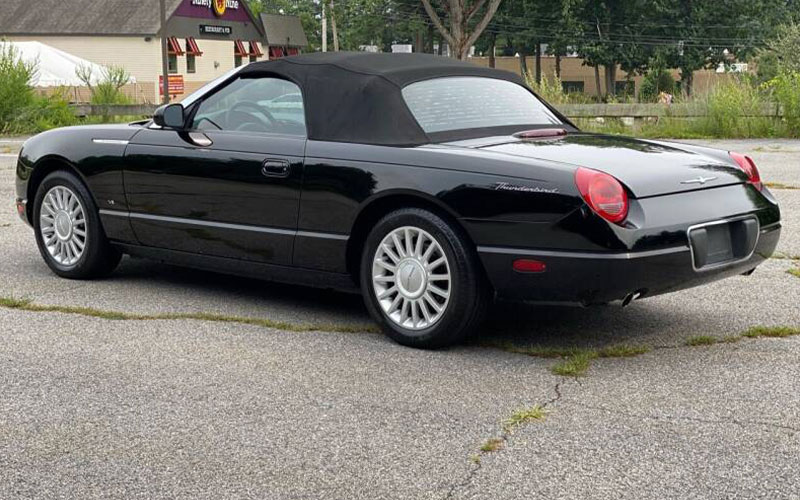
- The improved Ford Thunderbird could do 0-60 mph in 7 seconds.
- Although consumers loved the powerful V8, they criticized the eleventh-generation Thunderbird for its flexible body structure, non-sporting suspension, and mandatory automatic transmission.
- Ford referred to the new Ford Thunderbird as having a “relaxed sportiness.”
- This continued to lose favor with the public, and the last Ford Thunderbird left the production line in 2005.


